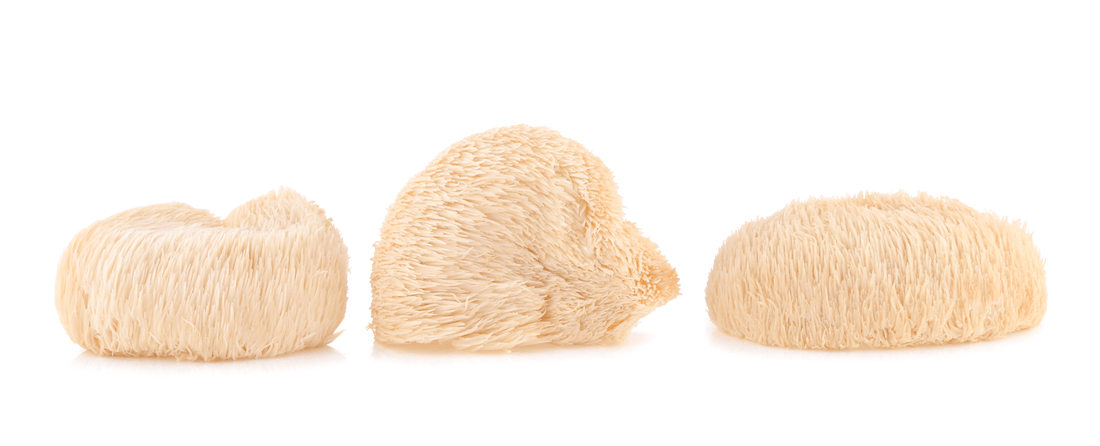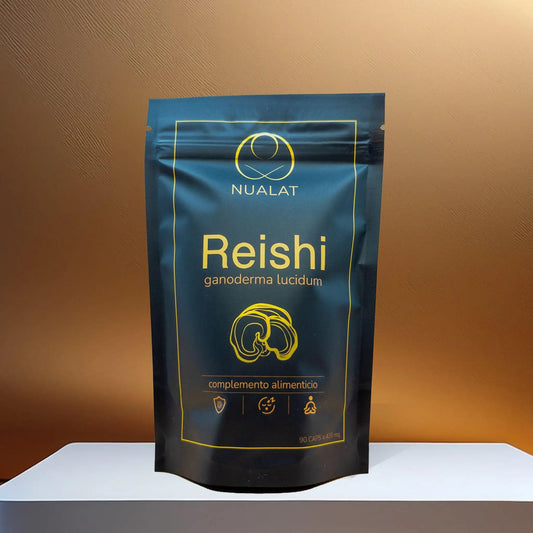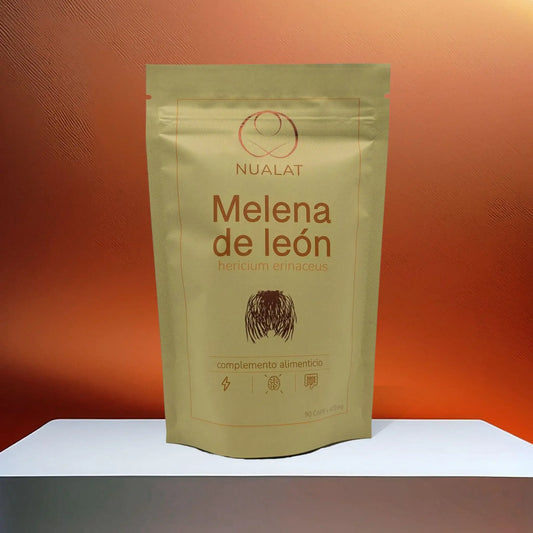
Lion's Mane: The Natural Adaptogen to Boost Memory and Concentration
Share
Hericium erinaceus , commonly known as Lion's Mane , is an edible and medicinal mushroom with a long history in traditional Chinese and Japanese medicine. Its distinctive appearance, reminiscent of a fluffy white mane, conceals a number of bioactive compounds with promising properties for the brain and nervous system.
In recent decades, it has aroused great interest in neuroscience due to its ability to stimulate Nerve Growth Factor (NGF) and other neurotrophins, molecules essential for the growth, maintenance and regeneration of neurons. In addition, it has been investigated for its potential to combat neurodegenerative diseases such as Alzheimer 's, Parkinson's and depression .
This article delves into the mechanisms of action, active compounds, and scientific findings supporting the benefits of Hericium erinaceus for brain and neuronal health.
Neurotrophins and their importance in the brain
What are Neurotrophins?
Neurotrophins are proteins that play a crucial role in the development, differentiation and survival of neurons. Among the most important neurotrophins are:
-
Nerve Growth Factor (NGF):
- Essential for the growth and survival of cholinergic neurons in the brain.
- It decreases with aging and in diseases such as Alzheimer's.
-
Brain-derived neurotrophic factor (BDNF):
- Promotes synaptic plasticity and learning.
- Low levels are associated with depression and other pathologies.
-
Neurotrophin 3 (NT-3) and Neurotrophin 4/5 (NT-4/5):
- They support the growth and maintenance of different types of neurons.
These proteins act through specific receptors such as TrkA , TrkB and p75NTR , which are found in the membrane of neuronal cells.
Neurotrophin Decline and Aging
Over time, neurotrophin levels naturally decline. This decline is linked to cognitive decline, memory loss, and an increased risk of neurodegenerative diseases. In Alzheimer’s patients, for example, reduced levels of NGF have been observed in critical regions such as the hippocampus and frontal cortex .
The ability of Hericium erinaceus to stimulate the synthesis of NGF and BDNF makes it a promising candidate to slow down or reverse these degenerative processes.
Chemical composition of Hericium erinaceus
Main Active Compounds
-
Erinacines :
- They stimulate the production of NGF by crossing the blood-brain barrier.
- Examples: Erinacin A , Erinacin C , Erinacin E.
-
Hericenones :
- Present in the fruiting body of the fungus.
- They promote NGF synthesis and have antioxidant effects.
- Examples: Hericenone C , Hericenone E , Hericenone H.
-
Polysaccharides and Beta-Glucans :
- They strengthen the immune system and protect against oxidative stress.
- They strengthen the immune system and protect against oxidative stress.
-
Ergothioneine :
- A powerful antioxidant that protects cells from oxidative damage.
These compounds work synergistically to offer a wide range of neuroprotective benefits.
Neuroprotective Action Mechanisms
Stimulation of NGF and BDNF
Lion's Mane promotes the synthesis of NGF and BDNF , proteins essential for the growth and regeneration of neurons. This stimulation is achieved thanks to the erinacins and hericenones present in the mushroom.
- Erinacin A increases NGF levels in the hippocampus and improves spatial memory in mice.
- Hericenone E induces NGF synthesis in glial cells, which improves synaptic plasticity.
Reduction of Oxidative Stress
Oxidative stress is a major cause of neuronal damage and is implicated in the development of diseases such as Alzheimer's and Parkinson's. The antioxidants present in Lion's Mane, such as ergothioneine and phenols , neutralize free radicals and protect neuronal membranes.
- In a study with PC12 cells, Hericium erinaceus polysaccharides were shown to protect against damage induced by beta-amyloid , a protein associated with Alzheimer's.
Anti-inflammatory effect
Chronic inflammation in the brain contributes to cognitive decline. Lion’s Mane extracts have been shown to reduce the production of pro-inflammatory cytokines such as IL-6 and TNF-α .
- Erinacin C reduced inflammation in microglial cells by inhibiting the NF-κB pathway, a key pathway in the inflammatory response.
Enhancement of Synaptic Plasticity
Synaptic plasticity is the brain's ability to form and reorganize synaptic connections. Lion's Mane improves this plasticity by increasing levels of NGF and BDNF.
Neuroprotective Action Mechanisms
Protection against Neuronal Apoptosis
Apoptosis is a process of programmed cell death that, if deregulated, can lead to progressive neuron loss, characteristic of diseases such as Alzheimer's and Parkinson's. Compounds from Hericium erinaceus may protect against apoptosis by influencing various molecular pathways.
-
Erinacin A :
- Studies in Neuro-2a cells showed that erinacin A reduces apoptosis by modulating transcription factors such as p53 and NF-κB .
- Additionally, it activates cell survival pathways such as PAK1 , AKT and LIMK2 , which help neurons resist damage.
-
Ethanolic Extract of Mycelium :
- In a model of cerebral ischemia in Sprague-Dawley rats, ethanolic extract of Hericium erinaceus mycelium reduced cerebral infarct volume and levels of proinflammatory cytokines such as IL-1β , IL-6 , and TNF-α .
Stimulation of Neurogenesis
Neurogenesis is the process by which new neurons are generated from stem cells. This process occurs mainly in the hippocampus , a key region for learning and memory. Hericium erinaceus has been shown to be effective in stimulating this process.
-
Erinacin S :
- In a study with cultures of mouse cortical neurons, erinacin S significantly increased neurite outgrowth and the formation of new synaptic connections.
- An accumulation of neurosteroids , which help neurogenesis and protect against neuronal apoptosis, was observed.
-
Oral Administration of Mycelium Enriched with Erinacin A :
- In APPswe/PS1dE9 mice, an Alzheimer's model, oral administration of mycelium enriched with erinacin A for 30 days increased the number of new neurons in the dentate gyrus of the hippocampus.
Neurotransmitter Modulation
Neurotransmitters such as dopamine , acetylcholine , and norepinephrine are essential for brain function. Lion's Mane may influence the levels of these neurotransmitters, improving mood, memory, and focus.
-
Dopamine in Parkinson's :
- In a mouse model of MPTP- induced Parkinson's disease, Hericium erinaceus mycelial extract significantly increased dopamine levels, protecting dopaminergic neurons from degeneration.
- In a mouse model of MPTP- induced Parkinson's disease, Hericium erinaceus mycelial extract significantly increased dopamine levels, protecting dopaminergic neurons from degeneration.
-
Acetylcholine in Alzheimer's :
- In mice with AlCl3- and D-galactose -induced Alzheimer's disease, administration of an aqueous extract of Hericium erinaceus increased acetylcholine (ACh) levels and choline acetyltransferase (ChAT) activity in the hippocampus.
Scientific Evidence in Neurodegenerative Diseases

1. Alzheimer
Alzheimer 's is a disease characterized by the accumulation of beta-amyloid plaques and neurofibrillary tangles in the brain, leading to neuron degeneration and memory loss.
-
Reduction of Beta-Amyloid Plaques :
-
Erinacin A reduced the burden of beta-amyloid plaques in the cerebral cortex and increased the expression of the insulin-degrading enzyme (IDE) , a key enzyme for clearing beta-amyloid plaques.
-
Erinacin A reduced the burden of beta-amyloid plaques in the cerebral cortex and increased the expression of the insulin-degrading enzyme (IDE) , a key enzyme for clearing beta-amyloid plaques.
-
Neuronal Regeneration :
- In a 16-week study of patients diagnosed with mild cognitive impairment, supplementation with 250 mg Hericium erinaceus tablets significantly improved scores on memory tests.
2. Parkinson
Parkinson's disease involves the progressive degeneration of dopaminergic neurons in the substantia nigra . This causes motor symptoms such as tremors, rigidity and bradykinesia.
-
Protection of Dopaminergic Neurons :
- Erinacin A protected dopaminergic neurons in a mouse model of MPTP-induced Parkinson's disease by activating cell survival pathways and reducing inflammation.
- Erinacin A protected dopaminergic neurons in a mouse model of MPTP-induced Parkinson's disease by activating cell survival pathways and reducing inflammation.
-
Functional Recovery :
- Studies in rats showed an improvement in motor coordination and a reduction in neuronal damage after administration of Hericium erinaceus extract.
3. Depression and Anxiety
Depression is associated with low levels of BDNF and chronic inflammation in the brain. Lion's Mane has shown antidepressant effects by modulating these factors.
-
Increased BDNF :
- In mice with stress-induced depression, Hericium erinaceus mycelial extract increased BDNF levels in the hippocampus and reduced levels of inflammatory cytokines.
- In mice with stress-induced depression, Hericium erinaceus mycelial extract increased BDNF levels in the hippocampus and reduced levels of inflammatory cytokines.
-
Human Clinical Trial :
- A study in menopausal women showed a significant reduction in anxiety and depression levels after consuming cookies enriched with Hericium erinaceus powder for 4 weeks.
Therapeutic Applications of Hericium erinaceus
1. Supplements for Cognitive Health
Hericium erinaceus supplements have been used for:
- Improve memory and concentration.
- Reduce symptoms of anxiety and depression.
- Prevent cognitive decline associated with aging.
2. Complementary Treatments for Neurodegenerative Diseases
- Alzheimer's : As a supplement to reduce beta-amyloid plaques and stimulate neurogenesis.
- Parkinson's : To protect dopaminergic neurons and improve motor function.
3. Recovery from Nerve Injuries
The aqueous extract of Hericium erinaceus has been shown to accelerate the regeneration of damaged nerves in animal models, suggesting its potential use in injuries to the peripheral nervous system.
Conclusion
Hericium erinaceus is a mushroom with neuroprotective and therapeutic properties widely supported by scientific studies. Its bioactive compounds, such as erinacins and hericenones , stimulate the production of NGF and BDNF, reduce oxidative stress, fight inflammation and protect against neuronal apoptosis. These effects make it a promising supplement to improve brain health and combat neurodegenerative diseases such as Alzheimer's, Parkinson's and depression.
Preclinical results and existing trials suggest that Hericium erinaceus may play a crucial role in neuroprotection and maintaining optimal cognitive function.
List of studies
-
Study on erinacine-induced NGF synthesis
- Reference : [Rupcic et al., 2018]
- Abstract : Erinacins A, B, C, and E extracted from the mycelium of Hericium erinaceus were shown to significantly stimulate NGF production in human 1321N1 cells. Furthermore, erinacin Z1 was also found to increase NGF expression.
-
Neuroprotection study in cerebral ischemia in rats
- Reference : [Lee et al., 2014]
- Abstract : Administration of ethanolic extract of Hericium erinaceus mycelium in Sprague-Dawley rats with cerebral ischemia reduced infarct volume and decreased levels of inflammatory cytokines such as IL-1β , IL-6 , and TNF-α .
-
Effect of erinacin A on neuronal protection against Parkinson's disease
- Reference : [Hsu et al., 2013]
- Abstract : In a mouse model of MPTP-induced Parkinson's disease , erinacin A protected dopaminergic neurons by activating signaling pathways such as PAK1 , AKT , and LIMK2 .
-
Peripheral nerve regeneration study
- Reference : [Wong et al., 2016]
- Abstract : Oral administration of an aqueous extract of fresh fruiting bodies of Hericium erinaceus promoted the regeneration of damaged peripheral nerves in Sprague-Dawley rats.
-
Antidepressant effects of Hericium erinaceus mycelium
- Reference : [Chong et al., 2019]
- Abstract : In mice with stress-induced depression, Hericium erinaceus mycelial extract increased BDNF levels in the hippocampus and reduced inflammatory cytokine levels.
-
Clinical trial in humans with mild cognitive impairment
- Reference : [Mori et al., 2009]
- Summary : A double-blind study showed that patients who took 250 mg of Hericium erinaceus tablets for 16 weeks improved their scores on tests of memory and cognitive function.
-
Study on the synthesis of acetylcholine in Alzheimer's
- Reference : [Zhang et al., 2016]
- Abstract : In mice with AlCl3- and D-galactose -induced Alzheimer's disease, aqueous extract of Hericium erinaceus increased acetylcholine (ACh) levels and choline acetyltransferase (ChAT) activity.
-
Study of the reduction of beta-amyloid plaques
- Reference : [Tzeng et al., 2018]
- Abstract : Oral administration of erinacin A-enriched mycelium reduced beta-amyloid plaques in the brain of transgenic mice with Alzheimer's disease.
-
Study of erinacin S-induced neurogenesis
- Reference : [Lin et al., 2014]
- Abstract : Erinacin S stimulated neurite outgrowth in mouse cortical neurons and increased neurosteroid accumulation, promoting neurogenesis.
-
Combined effect of Hericium erinaceus and garlic on recovery from ischemia
- Reference : [Kim et al., 2014]
- Abstract : A combined extract of Hericium erinaceus mycelium and garlic protected against neuronal death in a gerbil model of cerebral ischemia.
-
Study on synaptic plasticity in the hippocampus
- Reference : [Hazekawa et al., 2013]
- Abstract : Administration of an aqueous extract of Hericium erinaceus increased NGF levels and improved synaptic plasticity in the hippocampus of mice.
-
Effect of polysaccharides against oxidative damage
- Reference : [Cheng et al., 2016]
- Abstract : Hericium erinaceus polysaccharides protected PC12 cells from beta-amyloid- induced damage by reducing oxidative stress and apoptosis.






